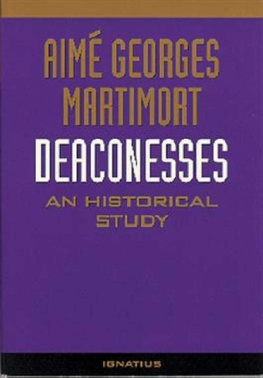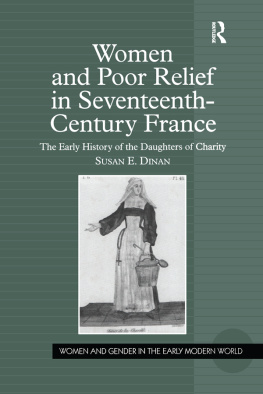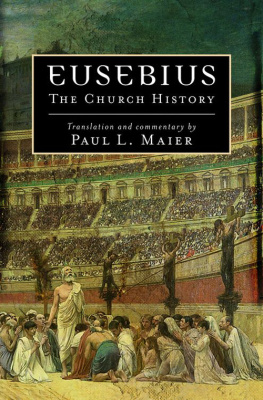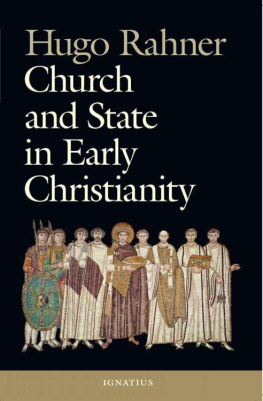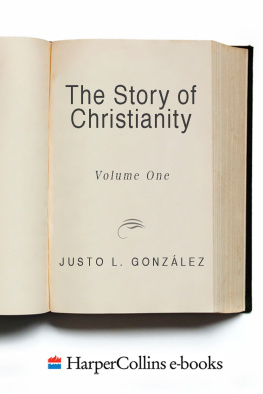DEACONESSES
An Historical Study
Aim Georges Martimort
DEACONESSES
An Historical Study
Translated by . D. Whitehead
Ignatius Press San Francisco
Title of the French original
Les Diaconesses: Essai historique
1982 C.L.V. Edizioni Liturgiche, Rome
Cover by Darlene Lawless
1986 Ignatius Press, San Francisco
All rights reserved
ISBN 978-0-89870-1 14-2 (PB)
ISBN 978-1-68149-763-1 (EB)
Library of Congress catalogue number 86-81423
Printed in the United States of America
Contents
New Testament Texts; Documents of the Second and Early Third Centuries
Deaconesses in the Greek-Speaking Churches and
the Churches of Oriental Languages
The Didascalia of the Apostles ; The Testament of Our Lord Jesus Christ (Testamentum Domini); The Practice of the Churches of Chaldea and Persia
The First Six Books of the Apostolic Constitutions and the Didascalia; The Baptismal Rituals of Book VII; Book VIII of the Apostolic Constitutions and the Apostolic Tradition of Hippolytus of Rome; The Canons Inserted into Book VIII; Documentary Value of the Apostolic Constitutions
The Exegesis of Clement of Alexandria and of Origen; The Ancient Collections of Canons; Euchologies and Rituals
:
I. In Church Teaching and Legislation
Deaconesses in Official Church Legislation; Deaconesses in Theological Treatises and Exegetical Commentaries
:
II. In the Life and Practice of the Church
Geographical Extension of the Institution of Deaconesses; Who Were the Deaconesses?; Functions of Deaconesses; The Case of Deaconesses in the Monasteries of the Region of Edessa; Supplementary Note
The Byzantine Ritual jor the Ordination of Deaconesses; The Chaldean Ritual for the Ordination of Deaconesses
Among the Jacobites of Tagrit; Among the Western Syrians; Among the Byzantines; Were There Deaconesses among the Maronites?; Were There Deaconesses among the Armenians and Georgians?; Conclusion
Deaconesses in the Latin Church
No Deaconesses in Rome, Africa or Spain; Opposition to the Institution of Deaconesses in Rome and in Gaul during the Fourth and Fifth Centuries
Widow-Deaconesses in Gaul in the Sixth Century; Wives of Deacons Called Deaconesses; The First Deaconesses in Italy (Seventh to Eighth Centuries); Deaconesses-Abbesses in Rome and Elsewhere (Tenth Century); The Silence of the Carolingian Legislation; The Pontifical of Saint Alban of Mainz (950) and its Utilization in Rome
Disappearance of the Ordo ad diaconam faciendam; Abelard and the Case of Heloise; Gratian and Peter Lombard; Glossarists and Theologians
Deaconesses in the Celebration of the Divine Office; The Case of Carthusian Nuns
Who and What Were Deaconesses?; Were They Deacons?; The Appraisal of the Theologians
Introduction
Since the seventeenth century the history of deaconesses in the Church has been the subject of numerous monographs. There are two modern works, however, that outclass everything written before them. The first of these is Adolf Kalsbachs Die Altkirchliche Einrichtung der Diakonisse bis zu ihrem Erlschen , published in 1926. The introduction to each of these works provides a complete bibliography of earlier works on the subject.
Given the existence of these two excellent works, is there room for yet another study? It seems to mc that there is, in part because the caution wisely recommended by Roger Gryson has not always been observed of late. He wrote that the conscientious historian, who is accustomed not to affirm anything except on the basis of careful and sustained research, is surely obliged to question the nave assurance of those for whom everything is simple and clear at first glance.
Another reason for an additional study, I believe, is the amount of light that can be thrown on the subject by looking at the liturgical formulas of both East and West, and also by extending the inquiry into the Middle Ages and even beyond by studying the documents of theology and canon law of the period. We cannot, of course, do more than sample the latter, since many of the applicable documents remain unpublished. Nevertheless, we must corroborateor correctthe testimony provided by purely liturgical books by looking also at other documentary sources. As is well known, liturgical books were often copied from earlier liturgical models, and they frequently preserved rites that had long since fallen into disuse. Thus it was that the Roman Pontifical of 1888 continued to include medieval ordines which had not been used for centuries: for example, the rite for the degradation of clerics. A similarly careful study must be made of compilations and collections of canon law, which often include texts from many sources and are of uneven value and sometimes uncertain authenticity.
Two methodical principles are required today for the type of inquiry I propose to conduct. First, in writing the history of any ecclesiastical institution, one must respect the particular geographical localities where the inscriptions and documents attesting to the existence of that ecclesiastical institution were produced. The churches of antiquity, like those of the Middle Ages, permitted and preserved great diversity in their ecclesiastical discipline, and there were numerous reciprocal influences at work. We must therefore examine a whole series of monographs relating to particular localities before ever venturing to construct a synthesisif indeed it is possible to construct such a synthesis even then.
Second, regarding the specific question of deaconesses, it is not enough that texts are available that attest to their existence. We must also attempt in each instance to understand who and what these deaconesses and their functions were, for the historical reality about them was constantly shifting and unstable: sometimes they were recruited from the ranks of widows, other times from the ranks of virgins. Often ecclesiastical legislation about them was conflicting or confused, as have been also both ancient and modern authors. Typically, they have simply been assimilated into the deaconesses mentioned in the Pastoral Epistles. One of the merits of the work of Roger Gryson is that it tries so patiently to unravel the tangled skein of evidence for the period of the early Church.
Having presented in as complete and objective a fashion as possible the history of deaconesses in their various concrete manifestations in history, I think it necessary to confront, at least in a modest way, the theological controversies that the institution of deaconesses in the Church has inspired in our own day. I will content myself with the reflections suggested to me by this inquiry, which extended over several years, and also, especially, with those reflections suggested to me by the history of the liturgy in general.
Rome, September 28, 1980
Abbreviations of the Works and
Collections Consulted
AASS = Acta sanctorum quotquot toto orbe coluntur.. . Antuerpiae, apud Ioannem Meursium (now: Brussels, Society of Bollandists), from 1643.
Andrieu OR = M. Andrieu, Les Ordines Romani du haut moyen ge , Louvain, 1931-61. 5 vols. ( Spicilegium sacrum Lovaniense.. . 11, 23, 24, 28, 29). Vol. of tables in preparation.
Andrieu PR = M. Andrieu, Le Pontifical romain au moyen ge , Vatican City, Biblioteca Apostolica Vaticana, 1938-41. ( Studi etesti , 86, 87, 88, 99). 4 vols.
BAC = Biblioteca de autores cristianos , Madrid, from 1944.
Baumstark, Geschichte der syrischen Literatur = A. Baumstark, Geschichte der syrischen Literatur, mit Ausschluss der christlich-palstinensichen Texte , Bonn, Marcus and Weber, 1922 (reprinted Berlin, 1968).
CCL = Corpus christianorum, Series Latina , Turnhout, Brepols, from 1954.
CCLCM = Corpus christianorum, Continuatio mediaevalis , Turnhout, Brepols, from 1971.
Next page
